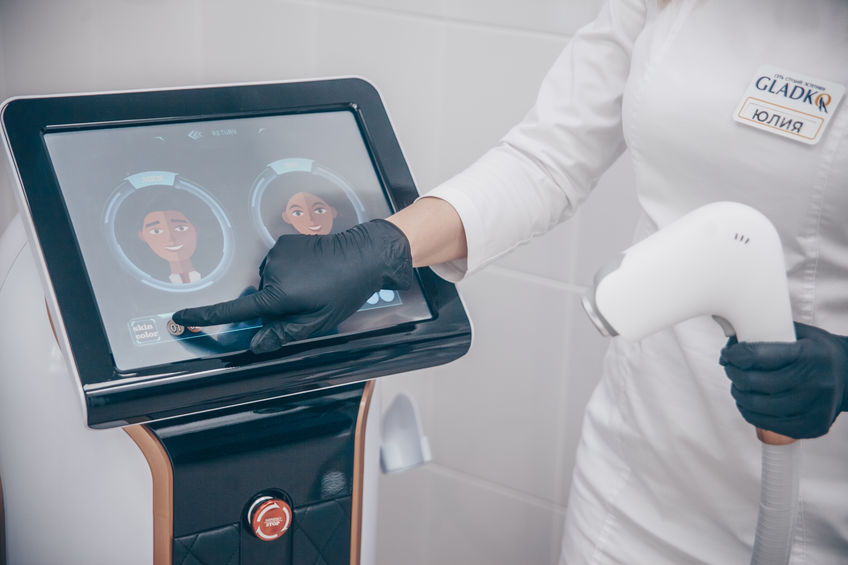Does Laser Hair Removal Work On Blonde Hair? Or White Hair Or Gray Hair?
Laser hair removal is widely perceived at working only on people who have dark hair. These days modern laser hair removal machines can safely and effectively help a wide variety of skin tones but hair color remains a difficult nut to crack.
As research has shown:
Patients with blond, gray, red, or white hair need to be aware that it is unlikely that laser treatment will result in permanent hair removal.
Science Direct
This is largely because the low level of melanin in their hair makes it difficult if not impossible for laser to penetrate it.
But what if unwanted hair was first treated with a darkening agent to attempt to make the hair more attractable to the laser light?

Does Laser Hair Removal Work On Blonde Hair
Diode Laser Hair Removal Research
We already discussed on this site the efficiency of dyeing your hair with a commercial hair dye product to attempt to darken the hair and treat it with laser or IPL hair removal. It doesn’t work very well.
But what if you were to repeatedly use a topical spray to darken the hair to better allow the hair to absorb the laser light and treat the unwanted hair successfully?
A Dutch report from 2007 titled A randomized, controlled, double-blind study evaluating melanin-encapsulated liposomes as a chromophore for laser hair removal of blond, white, and gray hair studied the effects of Diode laser hair removal on 16 people combined with the use of a liposomal melanin spray (Lipoxome) to darken the hair to better treat it with laser.
What were the final results?
Melanin-encapsulated liposomal spray in combination with diode laser treatment showed significant higher efficacy in the treatment of white and blond hair compared with a control group. However, the clinically observed hair reduction was so weak that additional effort as well as higher costs argues against the application of the tested formulation.
National Library of Medicine
In laymen’s terms, the hair reduction in the patients wasn’t worth the effort and cost of the process.
Research citation: Sand, Michael MD*; Bechara, Falk Georges MD*; Sand, Daniel BS†; Altmeyer, Peter MD*; Hoffmann, Klaus MD* A Randomized, Controlled, Double-Blind Study Evaluating Melanin-Encapsulated Liposomes as a Chromophore for Laser Hair Removal of Blond, White, and Gray Hair, Annals of Plastic Surgery: May 2007 – Volume 58 – Issue 5 – p 551-554 doi: 10.1097/01.sap.0000245129.53392.0e
A second Dutch report from 2010 titled Permanent hair removal of white, grey and light blond hair after laser treatment combined with melanin encapsulated liposomes. (Lipoxôme®) also studied the permanence of hair removal, this time involving 40 patients with unwanted hair that was white, gray or light blonde. The report combined Diode laser hair removal with a liposome spray to darken the hair follicles to gauge the efficiency of laser.
What were the final results?
This study came to a different conclusion. This study had the patients applying the Lipoxome themselves and found that the more Lipoxome was used, the better the hair removal results.
It can be concluded that the application of Lipoxôme was crucial for the success of the hair removing treatment. The patients with the best results regularly applied a quantity of 109 ml of Lipoxôme per treatment on average. The statistical analysis clearly shows that more Lipoxôme used leads to more hair removed.
Research Gate
As far as the actual hair removal results:
Six months after the last laser treatment, most patients (90.0%) had considerable hair reduction (75-100 %). 62,5 % of the patients achieved a permanent hair reduction between 95 – 100%.
Research Gate
This sounds pretty impressive. So what’s the problem?
Although the correlation between the use of the melanin-liposomes and the treatment results is significant, the problem in home treatment is the lack of control of patients’ compliance. Particularly patients showing good results at the beginning of the treatment are likely to reduce the application of the liposomes, this has a negative impact on the laser-treatment results.
Research Gate
Research citation: de Leeuw, Jaap & Beek, Nick & Neugebauer, Dieter. (2010). Permanent hair removal of white, grey and light blond hair after laser treatment combined with melanin encapsulated liposomes. (Lipoxôme®).
So the problem is that when patients were required to apply the liposome spray themselves multiple times per day for many days consecutively, over time people failed to do so consistently which negatively affected their results.
Personally, I noticed two things with this report that also stood out:
- The follow up time with patients was only 6 months after the last treatment which hardly gives a good indication of “permanent” hair removal since the full hair cycle lasts 6-7 years and it’s possible that the removed hair could grow back during that time.
- There were numerous spelling mistakes and typos in the report. I try my best on this site to ensure I don’t misspell words or have typos especially as I type quickly. But a professional research report like this needs to do better if it is to be taken seriously.

Conclusion
Laser hair removal has been historically difficult it not impossible for people with blonde, white and gray hair. You can include red haired people in that group, too. Would treating unwanted hair with a hair-darkening topical spray repeatedly prior to Diode laser hair removal treatment assist the hair removal process?
Two different research reports came to different conclusions regarding whether or not applying liposome spray to the skin prior to laser hair removal treatment works.
One report concluded that it did work well enough when compared to the time and cost involved to incorporate the liposome spray.
A second report found positive hair removal results when a Diode laser was used in conjunction with repeated liposome spray applications to the skin prior to treatment. But the amount of effort and time used to consistently apply the spray by the patient themselves directly impacted the success of the treatment. In short, people couldn’t be counted upon to do their job and apply the spray on a consistent basis even though the treatment itself was concluded as working! At least during the 6 month follow up time.
At this moment in time, successful removal of unwanted hair that is blonde, white or gray in color remains difficult if not impossible with laser hair removal technologies.
Recent Posts
Laser hair removal may not be as effective for individuals with red hair, as well as those with blonde, gray, or white hair, because the laser targets the pigment (melanin) in the hair follicle....
Laser remains a very popular form of hair removal and for several reasons. While not a permanent hair removal option like electrolysis, the benefit of laser is that it enables you to treat more...



